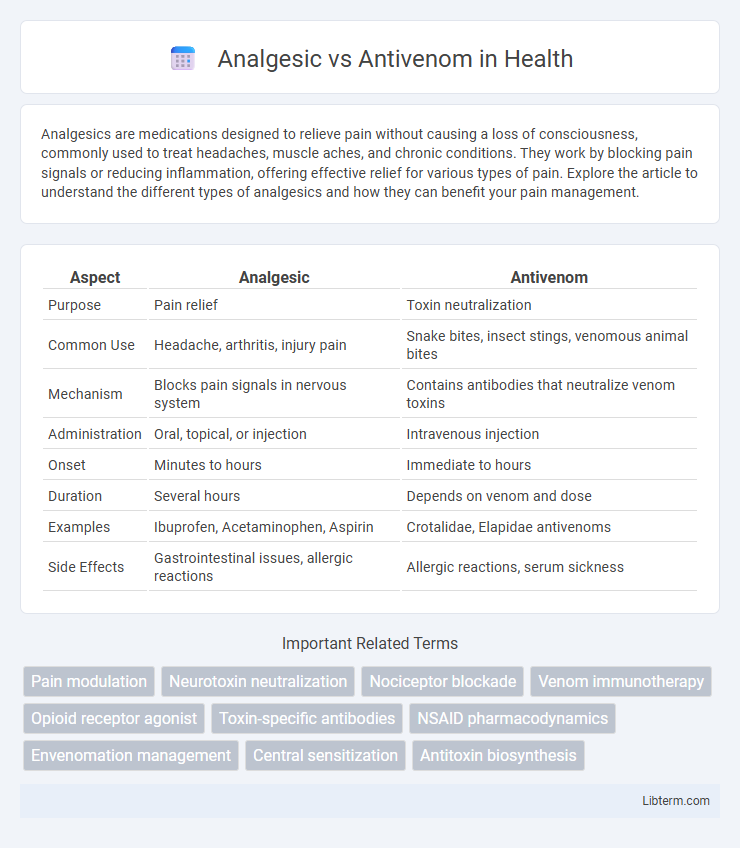Analgesics are medications designed to relieve pain without causing a loss of consciousness, commonly used to treat headaches, muscle aches, and chronic conditions. They work by blocking pain signals or reducing inflammation, offering effective relief for various types of pain. Explore the article to understand the different types of analgesics and how they can benefit your pain management.
Table of Comparison
| Aspect | Analgesic | Antivenom |
|---|---|---|
| Purpose | Pain relief | Toxin neutralization |
| Common Use | Headache, arthritis, injury pain | Snake bites, insect stings, venomous animal bites |
| Mechanism | Blocks pain signals in nervous system | Contains antibodies that neutralize venom toxins |
| Administration | Oral, topical, or injection | Intravenous injection |
| Onset | Minutes to hours | Immediate to hours |
| Duration | Several hours | Depends on venom and dose |
| Examples | Ibuprofen, Acetaminophen, Aspirin | Crotalidae, Elapidae antivenoms |
| Side Effects | Gastrointestinal issues, allergic reactions | Allergic reactions, serum sickness |
Introduction to Analgesics and Antivenoms
Analgesics are medications designed to relieve pain by targeting the nervous system, commonly used for conditions ranging from headaches to post-surgical discomfort. Antivenoms are specialized immunoglobulin therapies developed to neutralize venom toxins from bites or stings of venomous animals such as snakes, spiders, and scorpions. While analgesics primarily address pain symptoms, antivenoms directly counteract venom-induced toxicity, making both essential but distinct components in medical treatment.
Definitions: What are Analgesics?
Analgesics are medications designed to relieve pain without causing loss of consciousness, targeting pathways in the nervous system to reduce pain perception. Common types include nonsteroidal anti-inflammatory drugs (NSAIDs), acetaminophen, and opioids, each varying in mechanism and potency. Unlike antivenoms, which neutralize venom toxins from bites or stings, analgesics primarily manage pain symptoms rather than treating the cause.
Understanding Antivenoms: How They Work
Antivenoms are specialized biological products derived from the antibodies of immunized animals and function by neutralizing venom toxins from bites or stings, directly targeting harmful components of venom rather than merely alleviating pain. Analgesics, in contrast, only provide symptomatic relief by reducing pain perception without affecting the toxic impact of venom. Understanding the mechanism of antivenoms is crucial for effective treatment in envenomation cases since they address the root cause of toxicity instead of temporarily mitigating symptoms like analgesics.
Mechanisms of Action: Analgesics vs Antivenoms
Analgesics primarily work by blocking pain signals in the nervous system through mechanisms such as inhibiting cyclooxygenase enzymes to reduce prostaglandin synthesis or altering neurotransmitter activity to diminish pain perception. In contrast, antivenoms act by neutralizing venom toxins through specific antibodies that bind to venom components, preventing them from interacting with cellular targets and facilitating their elimination from the body. While analgesics alleviate symptoms of pain, antivenoms directly counteract the toxic effects of envenomation to prevent systemic damage.
Clinical Uses and Indications
Analgesics are primarily used to relieve pain from conditions such as arthritis, headaches, or postoperative discomfort, targeting the nervous system to reduce pain perception. Antivenoms are specifically indicated for treating envenomation caused by snake bites, spider bites, or scorpion stings, neutralizing venom toxins to prevent systemic toxicity and tissue damage. Clinical use of analgesics is supportive and symptom-based, whereas antivenom administration is definitive treatment for venom exposure with potentially life-threatening complications.
Side Effects and Safety Concerns
Analgesics, primarily used to relieve pain, may cause side effects such as gastrointestinal irritation, dizziness, or allergic reactions, with opioids posing risks of addiction and respiratory depression. Antivenoms, essential for treating venomous bites, carry potential side effects including anaphylaxis, serum sickness, and local injection site reactions, necessitating careful patient monitoring during administration. Safety concerns for both treatments emphasize the need for accurate dosing, vigilant observation of adverse reactions, and immediate medical intervention if complications arise.
Administration and Dosage Differences
Analgesics are administered primarily via oral, topical, or injectable routes to relieve pain, with dosage varying according to pain severity and patient response, often ranging from milligrams to grams per day. Antivenoms are administered intramuscularly or intravenously, with dosage precisely determined by the type and severity of envenomation, requiring careful titration to neutralize venom toxins effectively while minimizing adverse reactions. Unlike analgesics, antivenom administration demands medical supervision for dosage adjustment based on clinical symptoms and laboratory markers of envenomation.
Efficacy in Treating Pain and Venom Effects
Analgesics effectively relieve pain by targeting the nervous system's pain signals but do not neutralize venom toxins or halt their systemic effects. Antivenoms specifically bind to and neutralize venom components, reversing toxic effects and preventing tissue damage, though they have limited direct analgesic properties. Combining antivenom treatment with analgesics often results in optimal management of both venom-induced damage and associated pain.
Recent Advances in Pain Management and Envenomation
Recent advances in pain management highlight the development of targeted analgesics such as selective opioid receptor modulators and non-opioid peptides that provide effective relief with reduced side effects. In envenomation treatment, novel antivenoms employing recombinant DNA technology and monoclonal antibodies have improved specificity and efficacy against diverse venom toxins. Integration of rapid diagnostic tools with these advances enhances timely administration, optimizing patient outcomes in both analgesic therapy and envenomation cases.
Choosing the Right Treatment: Analgesic or Antivenom?
Choosing the right treatment depends on the underlying cause: analgesics are effective for pain relief by targeting nociceptive pathways, whereas antivenoms neutralize specific toxins from venomous bites or stings. Analgesics such as NSAIDs or opioids manage symptoms without addressing venom toxicity, making them unsuitable for envenomation cases. In contrast, antivenom therapy is critical for reversing systemic effects of venom, preventing organ damage, and improving survival rates in snakebite or scorpion sting patients.
Analgesic Infographic

 libterm.com
libterm.com